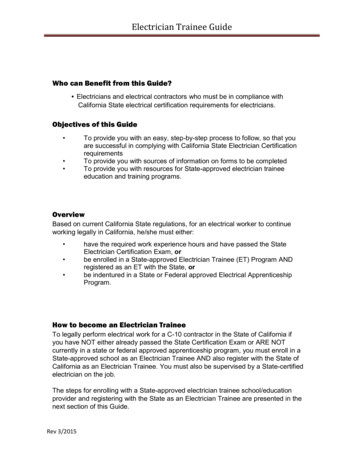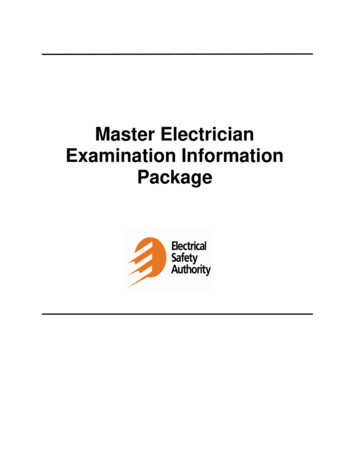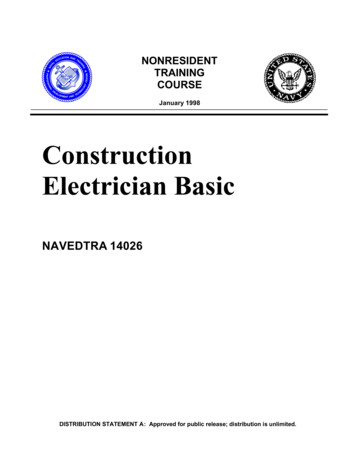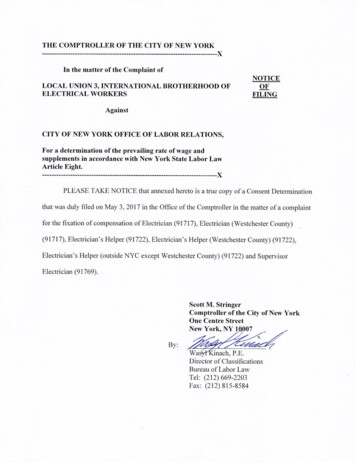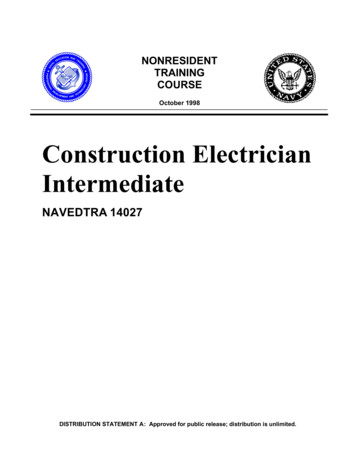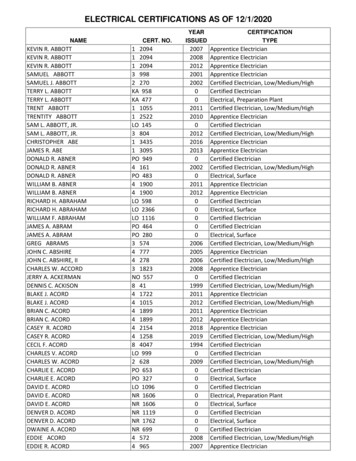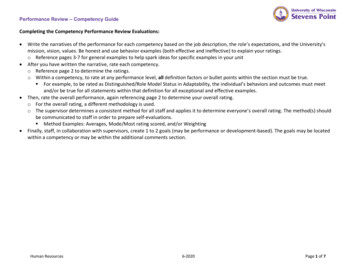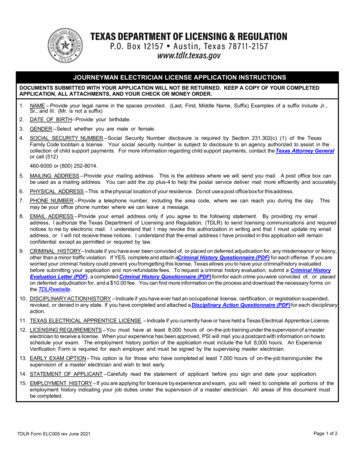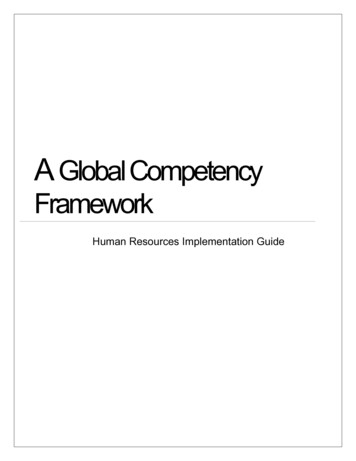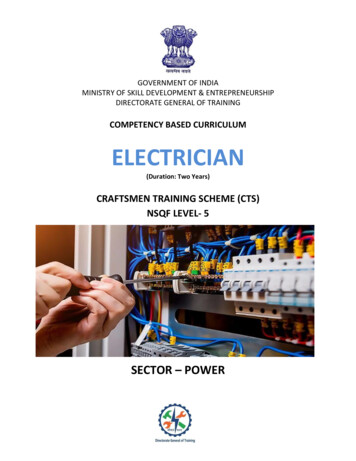
Transcription
GOVERNMENT OF INDIAMINISTRY OF SKILL DEVELOPMENT & ENTREPRENEURSHIPDIRECTORATE GENERAL OF TRAININGCOMPETENCY BASED CURRICULUMELECTRICIAN(Duration: Two Years)CRAFTSMEN TRAINING SCHEME (CTS)NSQF LEVEL- 5SECTOR – POWER
ELECTRICIAN(Engineering Trade)(Revised in 2019)Version: 1.2CRAFTSMEN TRAINING SCHEME (CTS)NSQF LEVEL- 5Developed ByMinistry of Skill Development and EntrepreneurshipDirectorate General of TrainingCENTRAL STAFF TRAINING AND RESEARCH INSTITUTEEN-81, Sector-V, Salt Lake City,Kolkata – 700 091www.cstaricalcutta.gov.in
CONTENTSS No.TopicsPage No.1.Course Information12.Training System23.Job Role64.General Information75.Learning Outcome106.Assessment Criteria117.Trade Syllabus188.Annexure I(List of Trade Tools & Equipment)419.Annexure II (List of Trade experts)50
Electrician1. COURSE INFORMATIONDuring the two years duration of Electrician trade a candidate is trained on professionalskills& knowledge, Engineering Drawing, Workshop Calculation & Science and Employabilityskill related to job role. In addition to this a candidate is entrusted to undertake project workand extracurricular activities to build up confidence. The Broad components covered during thecourse are given below:FIRST YEAR: In this year the trainee learns about safety and environment, use of fireextinguishers, artificial respiratory resuscitation to begin with. He gets the idea of trade tools &its standardization, identifies different types of conductors, cables & their skinning & jointmaking. Basic electrical laws like Kirchhoff’s law, ohm’s law, laws of resistances and theirapplication in different combinations of electrical circuit are practiced along with laws ofmagnetism. The trainee practices on circuit for single phase and poly-phase circuits for 3 wire/4 wire balanced & unbalanced loads. Skilling practice on different types & combination of cellsfor operation and maintenance is being done. Wiring practice with installation of differentaccessories like ICDP switch, distribution fuse box and mounting energy meters are practiced asper IE rules for hostel/residential building, workshop and its fault detection are done by trainee.The trainee will practice for pipe & plate earthing. Different types of light fitting are to be donelike HP/LP mercury vapour and sodium vapour are prominent. The trainee will practice ondifferent types of measuring instruments like multimeter, wattmeter, energy meter, phasesequences meter, frequency meter, for measurement of electrical parameters in single & threephase circuits. He will gain skill on range extension, calibration and testing of meters. Practicefor dismantling, assembling and testing of heating element equipment, induction heatingequipment, grinding machines and washing machines will be done by trainee. Skill will begained on transformer for operation, efficiency, series parallel operation, replacement oftransformer oil and combination of single-phase transformers for 3 phase operation. Thetrainee will practice on winding of small transformer.SECOND YEAR: In this year the trainee will study the details of electrical rotating machines viz.DC machines, induction motors, alternators & MG sets and practice on them. The trainee willpractice on determining characteristics, their performance analysis, starting, speed control andreversing direction of rotation of machines. He will practice on parallel operation &synchronization of alternators, winding practice and over hauling will be practiced for DCmachine and induction motors. Practices on diodes for bridge rectifier, switching devices &lifiers by electronic components, different wave shape generation and testing by CRO.Designing control cabinet, assembling control elements and their wiring are to be practiced.Speed control of AC/DC motors by electronic controller will be practiced. The trainee willpractice on testing, analyzing and repairing of voltage stabilizer, emergency light, batterycharger, UPS and inverter. He will gain knowledge of thermal, hydel, solar & wind energysystems. The trainee will practice on distribution system, domestic service line and accessories& their protection by practicing on relay and circuit breaker for operation and maintenance.1
Electrician2. TRAINING SYSTEM2.1 GENERALThe Directorate General of Training (DGT) under Ministry of Skill Development &Entrepreneurship offers a range of vocational training courses catering to the need of differentsectors of economy/ Labour market. The vocational training programmes are delivered underthe aegis of Directorate General of Training (DGT). Craftsman Training Scheme (CTS) withvariants and Apprenticeship Training Scheme (ATS) are two pioneer schemes of DGT forstrengthening vocational training.Electrician trade under CTS is one of the most popular courses delivered nationwidethrough network of ITIs. The course is of two years duration. It mainly consists of Domain areaand Core area. The Domain area (Trade Theory & Practical) impart professional skills andknowledge, while Core area(Workshop Calculation and science, Engineering Drawing andEmployability Skills) impart requisite core skill, knowledge and life skills.After passing out of thetraining programme, the trainee is awarded National Trade Certificate (NTC) by DGT which isrecognized worldwide.Trainees broadly need to demonstrate that they are able to: Read and interpret technical parameters/ documents, plan and organize workprocesses, identify necessary materials and tools;Perform task with due consideration to safety rules, accident prevention regulations andenvironmental protection stipulations;Apply professional skill, knowledge & employability skills while performing jobs.Check the job/ assembly as per drawing for functioning identify and rectify errors in job/assembly.Document the technical parameters related to the task undertaken.2.2 PROGRESSION PATHWAYS Can join industry as Technician and will progress further as Senior Technician, Supervisorand can rise up to the level of Manager.Can become Entrepreneur in the related field.Can appear in 10 2 examination through National Institute of Open Schooling (NIOS) foracquiring higher secondary certificate and can go further for General/ TechnicaleducationCan take admission in diploma course in notified branches of Engineering by lateralentry.2
Electrician Can join Apprenticeship programme in different types of industries leading to NationalApprenticeship certificate (NAC).Can join Crafts Instructor Training Scheme (CITS) in the trade for becoming instructor inITIs.Can join Advanced Diploma (Vocational) courses under DGT as applicable.2.3 COURSE STRUCTURETable below depicts the distribution of training hours across various course elementsduring a period of two-years: Notional Training HoursS No.Course Element1st Year2nd Year1Professional Skill (Trade Practical)100010002Professional Knowledge (Trade Theory)2803603Workshop Calculation & Science80804Engineering Drawing80805Employability Skills1608016001600Total2.4 ASSESSMENT & CERTIFICATIONThe trainee will be tested for his skill, knowledge and attitude during the period of coursethrough formative assessment and at the end of the training programme through summativeassessment as notified by the DGT from time to time.a) The Continuous Assessment (Internal)during the period of training will be done byFormative Assessment Method by testing for assessment criteria listed against learningoutcomes. The training institute has to maintain individual trainee portfolio as detailed inassessment guideline. The marks of internal assessment will be as per the formative assessmenttemplate provided on www.bharatskills.gov.in.b) The final assessment will be in the form of summative assessment. The All India Trade Testfor awarding NTC will be conducted by Controller of examinations, DGT as per the guidelines.The pattern and marking structure is being notified by DGT from time to time. The learningoutcome and assessment criteria will be basis for setting question papers for finalassessment. The examiner during final examination will also check individual trainee’s profileas detailed in assessment guideline before giving marks for practical examination.3
Electrician2.4.1 PASS REGULATIONFor the purposes of determining the overall result, weightage of 100% is applied for sixmonths and one year duration courses and 50% weightage is applied to each examination fortwo years courses. The minimum pass percent for Trade Practical and Formative assessment is60% & for all other subjects is 33%. There will be no Grace marks.2.4.2 ASSESSMENT GUIDELINEAppropriate arrangements should be made to ensure that there will be no artificialbarriers to assessment. The nature of special needs should be taken into account whileundertaking assessment. Due consideration should be given while assessing for teamwork,avoidance/reduction of scrap/wastage and disposal of scrap/wastage as per procedure,behavioral attitude, sensitivity to environment and regularity in training. The sensitivity towardsOSHE (Occupational Safety & Health Environment) and self-learning attitude are to beconsidered while assessing competencies.Assessment will be evidence based, comprising the following: Job carried out in labs/workshop Record book/ daily diary Answer sheet of assessment Viva-voce Progress chart Attendance and punctuality Assignment Project workEvidences and records of internal (Formative) assessments are to be preserved untilforthcoming examination for audit and verification by examination body. The following markingpattern to be adopted while assessing:Performance LevelEvidence(a) Weightage in the range of 60 -75% to be allotted during assessmentFor performance in this grade, the candidateshould produce work which demonstratesattainment of an acceptable standard ofcraftsmanship with occasional guidance, and dueregard for safety procedures and practices.4 Demonstration of good skill in the use ofhand tools, machine tools and workshopequipment. 60-70%accuracyachievedwhileundertaking different work with thosedemanded by the component/job.
Electrician A fairly good level of neatness andconsistency in the finish. Occasional support in completing theproject/job.(b)Weightage in the range of above75% - 90% to be allotted during assessment Good skill levels in the use of hand tools,machine tools and workshop equipment. 70-80%accuracyachievedwhileundertaking different work with thosedemanded by the component/job. A good level of neatness and consistency inthe finish Little support in completing theproject/job.(c) Weightage in the range of above 90% to be allotted during assessmentFor this grade, a candidate should produce workwhich demonstrates attainment of a reasonablestandard of craftsmanship, with little guidance,and regard for safety procedures and practices.For performance in this grade, the candidate, withminimal or no support in organization andexecution and with due regard for safetyprocedures and practices, has produced workwhich demonstrates attainment of a highstandard of craftsmanship.5 High skill levels in the use of hand tools,machine tools and workshop equipment. Above 80% accuracy achieved whileundertaking different work with thosedemanded by the component/job. A high level of neatness and consistency inthe finish. Minimal or no support in completing theproject.
Electrician3. JOB ROLEElectrician General; installs, maintains and repairs electrical machinery equipment and fittingsin factories, workshops powerhouse, business and residential premises etc. Studies drawingsand other specifications to determine electrical circuit, installation details etc. Positions andinstalls electrical motors, transformers, switchgears. Switch boards and other electricalequipment, fittings and lighting fixtures. Makes connections and solders terminals. Testselectrical installations and equipment and locates faults using megger, test lamps etc. Repairsor replaces defective wiring, burnt out fuses and defective parts and keeps fittings and fixturesin working order. May do armature winding, draw wires and cables and do simple cablejointing. May operate, attend and maintain electrical motors, pumps etc.Electrical Fitter; fits and assembles electrical machinery and equipment such as motors,transformers, generators, switchgears, fans etc., Studies drawings and wiring diagrams offittings, wiring and assemblies to be made. Collects prefabricated electrical and mechanicalcomponents according to drawing and wiring diagrams and checks them with gauges, meggeretc. to ensure proper function and accuracy. Fits mechanical components, resistance,insulators, etc., as per specifications, doing supplementary tooling where necessary. Followswiring diagrams, makes electrical connections and solders points as specified. Checks forcontinuity, resistance, circuit shorting, leakage, earthing, etc. at each stage of assembly usingmegger, ammeter, voltmeter and other appliances and ensures stipulated performance of bothmechanical and electrical components filled in assembly. Erects various equipment such as busbars, panel boards, electrical posts, fuse boxes switch gears, meters, relays etc. using nonconductors, insulation hoisting equipment as necessary for receipt and distribution of electricalcurrent to feeder lines. Installs motors, generators, transformer etc. as per drawings usinglifting and hoisting equipment as necessary, does prescribed electrical wiring, and connects tosupply line. Locates faults in case of breakdown and replaces blown out fuse, burnt coils,switches, conductors etc. as required. Checks, dismantles, repairs and overhauls electrical unitsperiodically or as required according to scheduled procedure. May test coils. May specialize inrepairs of particular equipment manufacturing, installation or powerhouse work and bedesignated accordingly.Reference NCO-2015:(i) 7411.0100 – Electrician General(ii) 7412.0200 – Electrical Fitter6
Electrician4. GENERAL INFORMATIONName of the TradeELECTRICIANTrade CodeDGT/1001NCO - 20157411.0100, 7412.0200NSQF LevelLevel-5Duration of CraftsmenTraining (InstructionalHours)Two Years (3200 Hours)Entry QualificationPassed 10th class examination with Science and Mathematics or itsequivalent.Minimum Age14 years as on first day of academic session.Eligibility for PwDLD, LC, DW, AA, DEAF, HHUnit Strength (No. OfStudent)20 (There is no separate provision of supernumerary seats)Space Norms98 Sq. mPower Norms5.2 KW (for two units in one shift)Instructors Qualification for(i) Electrician TradeB.Voc/Degree in Electrical/ Electrical and Electronics Engineeringfrom AICTE/UGC recognized Engineering College/ university withone-year experience in the relevant field.OR03 years Diploma in Electrical/ Electrical and Electronics Engineeringfrom AICTE/recognized board of technical education or relevantAdvanced Diploma (Vocational) from DGT with two years’experience in the relevant field.ORNTC/NAC passed in the trade of "Electrician" with three years’experience in the relevant field.Essential Qualification:Relevant National Craft Instructor Certificate (NCIC) in any of thevariants under DGT.7
Electrician(ii) WorkshopCalculation & ScienceNOTE: Out of two Instructors required for the unit of 2(1 1), onemust have Degree/Diploma and other must have NTC/NACqualifications. However, both of them must possess NCIC in any ofits variants.B.Voc/Degree in Engineering from AICTE/UGC recognizedEngineering College/ university with one-year experience in therelevant field.OR03 years Diploma in Engineering from AICTE/recognized board oftechnical education or relevant Advanced Diploma (Vocational)from DGT with two years’ experience in the relevant field.ORNTC/ NAC in any one of the engineering trades with three years’experience.Essential Qualification:National Craft Instructor Certificate (NCIC) in relevant tradeOR(iii) Engineering DrawingNCIC in RoDA or any of its variants under DGTB.Voc/Degree in Engineering from AICTE/UGC recognizedEngineering College/ university with one-year experience in therelevant field.OR03 years Diploma in Engineering from AICTE/ recognized board oftechnical education or relevant Advanced Diploma (Vocational)from DGT with two years’ experience in the relevant field.ORNTC/ NAC in any one of the Electrical groups (Gr-II) tradescategorized under Engg. Drawing’/ D’man Mechanical / D’man Civil’with three years’ experience.(iv) Employability SkillEssential Qualification:National Craft Instructor Certificate (NCIC) in relevant tradeORNCIC in RoDA / D’man (Mech /civil) or any of its variants under DGT.MBA/ BBA / Any Graduate/ Diploma in any discipline with Twoyears’ experience with short term ToT Course in Employability Skillsfrom DGT institutes.8
Electrician(Must have studied English/ Communication Skills and BasicComputer at 12th / Diploma level and above)ORExisting Social Studies Instructors in ITIs with short term ToT Coursein Employability Skills from DGT institutes.21 years(v) Minimum age forInstructorList of Tools & EquipmentAs per Annexure-IDistribution of training on Hourly basis: (Indicative only)YearTotal Hrs./weekTradePracticalTradeTheoryWorkshopCal. & Sc.Engg.Drawing1st40 Hours25 Hours7 Hours2 Hours2 Hours2nd40 Hours25 Hours9 Hours2 Hours2 Hours9EmployabilitySkills4 Hours2 Hours
Electrician5. LEARNING OUTCOMELearning outcomes are a reflection of total competencies of a trainee and assessmentwill be carried out as per the assessment criteria.5.1 LEARNING OUTCOMES (TRADE SPECIFIC)FIRST YEAR1. Prepare profile with an appropriate accuracy as per drawing following safetyprecautions.2. Prepare electrical wire joints; carry out soldering, crimping and measure insulationresistance of underground cable.3. Verify characteristics of electrical and magnetic circuits.4. Install, test and maintenance of batteries and solar cell.5. Estimate, Assemble, install and test wiring system.6. Plan and prepare Earthing installation.7. Plan and execute electrical illumination system and test.8. Select and perform measurements using analog / digital instruments.9. Perform testing, verify errors and calibrate instruments.10. Plan and carry out installation, fault detection and repairing of domestic appliances.11. Execute testing, evaluate performance and maintenance of transformer.SECOND YEAR12. Plan, execute commissioning and evaluate performance of DC machines.13. Execute testing, and maintenance of DC machines and motor starters.14. Plan execute commissioning and evaluate performance of AC motors.15. Execute testing, and maintenance of AC motors and starters.16. Plan, execute testing, evaluate performance and carry out maintenance of Alternator/ MG set.17. Execute parallel operation of alternators.18. Distinguish, organise and perform motor winding.19. Assemble simple electronic circuits and test for functioning.20. Assemble accessories and carry out wiring of control cabinets and equipment.21. Perform speed control of AC and DC motors by using solid state devices.22. Detect the faults and troubleshoot inverter, stabilizer, battery charger, emergencylight and UPS etc.23. Plan, assemble and install solar panel.24. Erect overhead domestic service line and outline various power plant layout.25. Examine the faults and carry out repairing of circuit breakers.10
Electrician6. ASSESSMENT CRITERIALEARNING OUTCOMESASSESSMENT CRITERIAFIRST YEAR1.Prepare profile with anappropriate accuracyas per drawing.Identify the trade tools; demonstrate their uses with safety, care &maintenance.Prepare a simple half lap joint using firmer chisel with safety.Prepare tray using sheet metal with the safety.Demonstrate fixing of surface mounting type of accessories.Perform connections of electrical accessories.Make and wire up of a test board and test it.2.Prepare electrical wirejoints, carry outsoldering, crimping andmeasure insulationresistance ofunderground cable.Observe safety/ precaution during joints & soldering.Make simple straight twist and rat-tail joints in single strandconductors.Make married and ‘T’ (Tee) joint in stranded conductors.Prepare a Britannia straight and ‘T’ (Tee) joint in bare conductors.Prepare western union joint in bare conductor.Solder the finished copper conductor joints with precaution.Prepare termination of cable lugs by using crimping tool.Make straight joint in different types of underground cables.Measure insulation resistance of underground cable.3.Verify characteristics of Identify types of wires, cables and verify their specifications.electrical and magnetic Verify the characteristics of series, parallel and its combinationcircuits.circuit.Analyze the effect of the short and open in series and parallel circuits.Verify the relation of voltage components of RLC series circuit in AC.Determine the power factor by direct and indirect methods in an ACsingle phase RLC parallel circuit.Identify the phase sequence of a 3 ø supply using a phase-sequencemeter.Prepare/ connect a lamp load in star and delta and determinerelationship between line and phase values with precaution.Connect balanced and unbalanced loads in 3 phase star system andmeasure the power of 3 phase loads.Make the solenoid and determine its polarity for the given directionof current.Group the given capacitors to get the required capacity and voltage11
Electricianrating.4.Install, test andmaintenance ofbatteries and solar cell.Assemble a DC source 6V/500 mA using 1.5V cells.Determine the internal resistance of cell and make grouping of cells.Explain charging of battery and test for its condition with safety/precaution.Carry out installation and maintenance of batteries.Determine total number of cells required for a given powerrequirement.5.Estimate, Assemble,install and test wiringsystem.Comply with safety & IE rules when performing the wiring.Prepare and mount the energy meter board.Draw and wire up the consumers main board with ICDP switch anddistribution fuse box.Draw and wire up a bank/hostel/jail in PVC conduit.Identify the types of fuses their ratings and applications.Identify the parts of a relay, MCB & ELCB and check its operation.Estimate the cost of material for wiring in PVC channel for an officeroom having 2 lamps, 1 Fan, one 6A socket outlet and wire up.Estimate the requirement for conduit wiring (3 phase) and wire up.Estimate the materials and wire up the lighting circuit for a godown.Estimate the materials and wire up a lighting circuit for a corridor inconduit.Test, locate the fault and repair a domestic wiring installation.6.Plan and prepareEarthing installation.Plan work in compliance with standard safety norms related withearthing installation.Install the pipe earthing and test it.Install the plate earthing and test it.Measure the earth electrode resistance using earth tester.Carry out earth resistance improvement.7.Plan and executeelectrical illuminationsystem and test.Plan work in compliance with standard safety norms related withelectrical illumination system.Install light fitting with reflectors for direct and indirect lighting.Assemble and connect a single twin tube fluorescent light.Connect, install and test the HPMV & HPSV lamp with accessories.12
ElectricianPrepare and test a decorative serial lamp set for 240 V using 6V bulband flasher.Install light fitting for show case window lighting.8.Select and performmeasurements usinganalog / digitalinstrumentsIdentify the type of electrical instruments.Extend the range of MC voltmeter and ammeter.Measure the frequency by frequency meter.Measure the power and energy in a single & three phase circuit usingwattmeter and energy meter with CT and PT.Measure the value of resistance, voltage and current using digitalmultimeter.Measure the power factor in poly-phase circuit and verify the samewith voltmeter, ammeter, watt-meter readings.9.Perform testing, verifyerrors and calibrateinstruments.Test single phase energy meter for its errors.Determine the measurement errors while measuring resistance byvoltage drop method.Calibrate the analog multimeter.10. Plan and carry outinstallation, faultdetection and repairingof domestic appliances.Plan work in compliance with standard safety norms related withdomestic appliances.Service and Repair of calling bell/ buzzer/ Alarm.Service and repair an automatic iron.Repair and service of oven having multi-range heat control.Replace the heating element in a kettle and test.Service and repair an induction heater.Service and repair a geyser.Service and repair a mixer.Service and repair of washing machine.Install a pump set.Service and repair of table fan.Service, repair and install a ceiling fan.11. Execute testing,evaluate performanceand maintenance oftransformer.Plan work in compliance with standard safety norms related withtransformer.Identify the types of transformers and their specifications.Identify the terminals; verify the transformation ratio of a singlephase transformer.13
ElectricianConnect and test a single-phase auto- transformer.Determine the losses (iron loss and copper loss) and the regulation ofa single-phase transformer at different loads.Measure the current and voltage using CT and PT.Carry out winding for small transformer of 1KVA rating.Test the transformer oil with oil testing kit.Connect 3 single phase transformers for 3 phase operation of deltadelta /delta-star /star-star /star-delta.Connect the given two single phase transformers in parallel /series(secondary only) and measure voltage.Connect & test 3 phase transformer in parallel.SECOND YEAR12. Plan, executecommissioning andevaluate performanceof DC machines.Plan work in compliance with standard safety norms related with DCmachines.Determine the load performance of a different type of DC generatoron load.Connect, start, run and reverse direction of rotation of differenttypes of DC motors.Conduct the load performance tests on different type of DC motor.Control the speed of a DC motor by different method.13. Execute testing, andmaintenance of DCmachines and motorstarters.Test a DC machine for continuity and insulation resistance.Maintenance, troubleshooting & servicing of DC machines.Test armature by using growler.Maintain, service and troubleshoot the DC motor starter.14. Plan, executecommissioning andevaluate performanceof AC motors.Plan work in compliance with standard safety norms related with ACmotors.Draw circuit diagram and connect forward & reverse a 3-phasesquirrel cage induction motor.Start, run and reverse an AC 3 phase squirrel cage induction motor bydifferent type of starters.Measure the slip of 3 phase squirrel cage induction motor bytachometer for different output. Draw slip/ load characteristics of themotor.Determine the efficiency of 3 phase squirrel cage induction motor byno load test/ blocked rotor test and brake test.Plot the speed torque (Slip/Torque) characteristics of slip ring14
Electricianinduction motor.Demonstrate speed control of 3 phase induction motor.Connect, start and run a 3-phase synchronous motor.Connect start, run, control speed and reverse the DOR of differenttype of single-phase motors.Install a single-phase AC motor.15. Execute testing, andmaintenance of ACmotors and starters.Test continuity and insulation of various AC motors.16. Plan, execute testing,evaluate performanceand carry outmaintenance ofAlternator / MG set.Plan work in compliance with standard safety norms related withAlternator & MG set.Maintain, service and troubleshoot of three phase AC motors.Maintain, service and troubleshoot of different types of single-phaseAC motors.Maintain, service and troubleshoot the AC motor starter.Connect start and run an alternator and build up the voltage.Determine the load performance of a 3-phase alternator.Start and load a MG set with 3 phase induction motor coupled to DCshunt generator and build up the voltage.Perform/ Explain alignment of MG set.Preventive and breakdown maintenance of alternator / MG set.Explain the effect of excitation current in terms of V-curves ofsynchronous motor.17. Execute paralleloperation ofalternators.Demonstrate parallel operation of an alternator Bright lamp method/Dark lamp method/ Bright and dark lamp method18. Distinguish, organiseand perform motorwinding.Rewind the field coil /armature winding/ table fan /ceiling fan.Parallel operation of an alternator by using synchro scope.Draw winding diagram & rewind a single-phase split type motor(Concentric coil winding).Draw winding diagram & rewind a 3-phase squirrel cage inductionmotor (single layer distributed winding).Draw winding diagram & rewind a 3-phase induction motor (singlelayer concentric type half coil connection).Draw winding diagram & rewind a 3-phase squired cage inductionmotor. (Double layer distributed type winding)15
Electrician19. Assemble simpleelectronic circuits andtest for functioning.Perform soldering on components/ lug / board with safety.Identify the passive /active components by visual appearance, codenumber and test for their condition.Identify the control and functional switches in CRO and measure theD.C. & A.C. voltage, frequency and time period.Construct and test a half &full wave rectifier with and without filtercircuits.Construct circuit by using transistor as a switch.Construct and test a UJT as relaxation oscillator & electronic timer.Construct amplifier circuit using Transistor, FET and JFET and test.Construct and test lamp dimmer using TRIAC/DIAC.Test IGBT and use in circuit for suitable operation.Construct and test the universal motor speed controller using SCRwith safety.Construct and test logic gate circuits.20. Assemble accessoriesand carry out wiring ofcontrol cabinets andequipment.Draw the layout diagram of 3 phase AC motor control cabinet.Mount the control elements & wiring accessories on the controlpanel.Carry out wiring in control cabinet for local and remote control ofinduction motor.Draw & wire up the control panel for forward/ reverse operation ofinduction motor.Perform wiring for automatic start delta start
Electrician During the two years duration of Electrician trade a candidate is trained on professional skills& knowledge, Engineering Drawing, Workshop Calculation & Science and Employability skill related to job role. In addition to this a candidate is entrusted to undertake project wo
